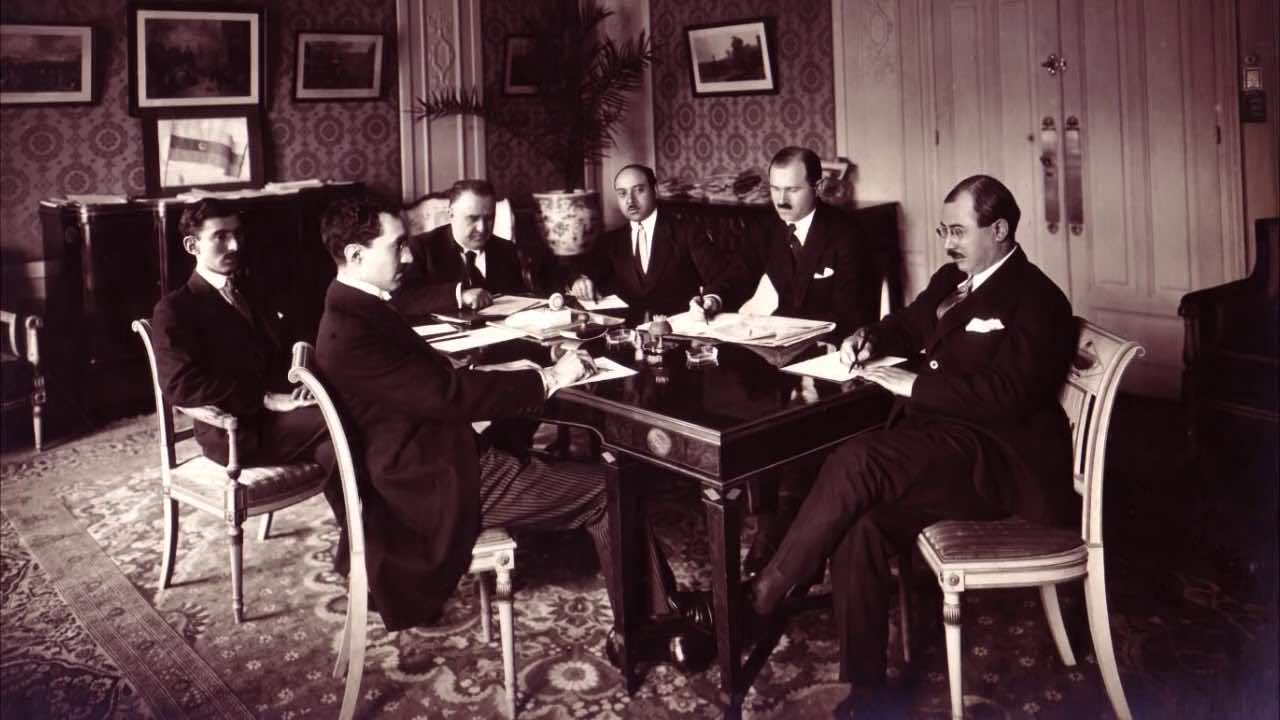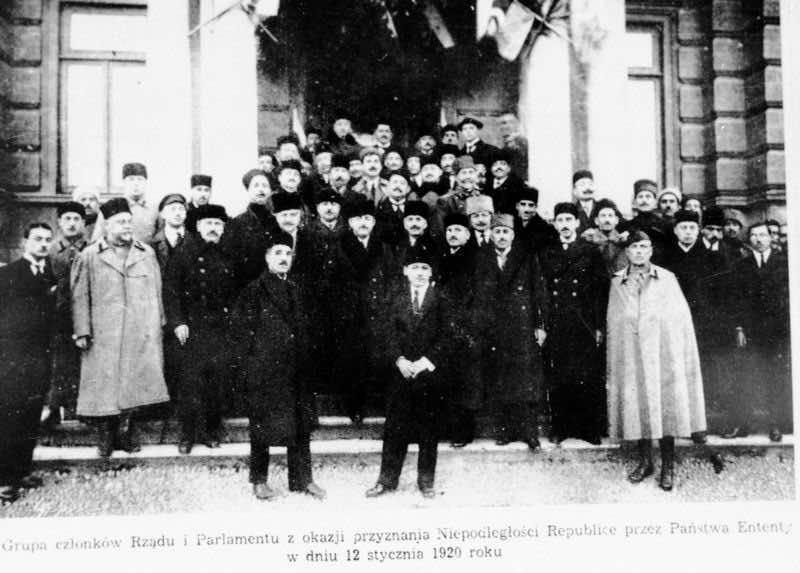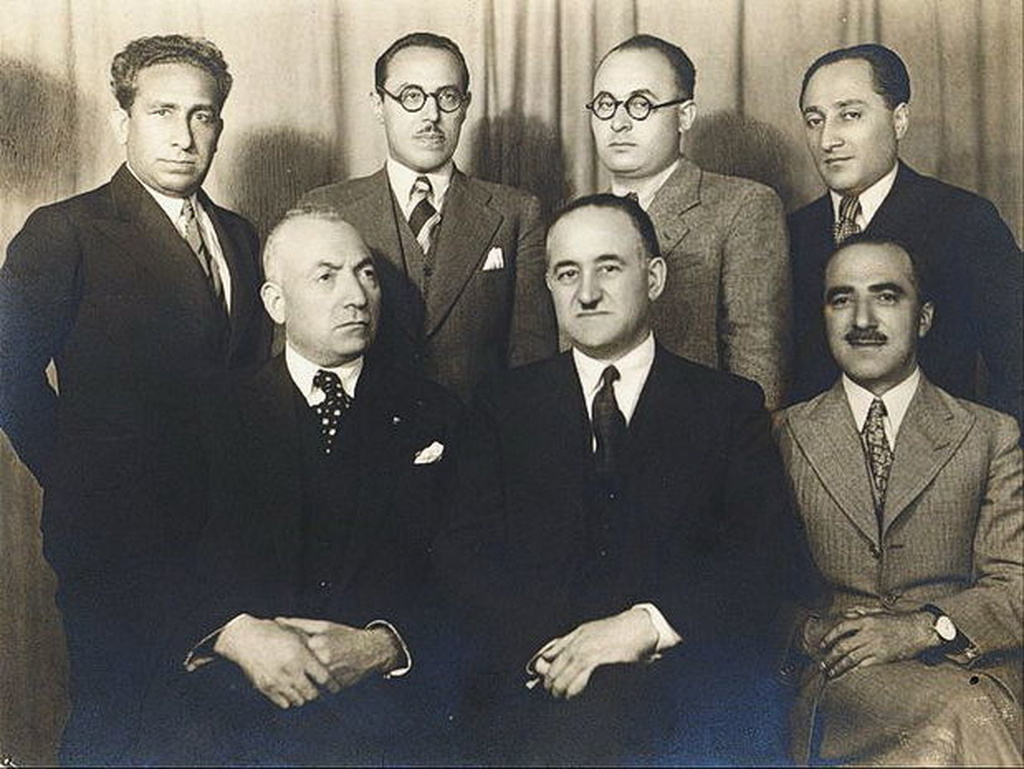Independence Day
The establishment of Democratic Republic of Azerbaijan on May 28, 1918 was a historic event and one of the glorious pages in our history. This significant date is celebrated as Independence Day in Azerbaijan anniversarily.
In February 1917, monarchic regime in Russia was overthrown. The Provisional Government that replaced the monarchy held elections to the Constituent Assembly.
However the Provisional Government was quite short-lived. In October 1917 coup d'etat occurred. As a result the members of parliament to the Russian Constituent Assembly from the Southern Caucasus could not go to Russia. Instead on February 14, 1918, in Tiflis they founded the Supreme Power of the Transcaucasia the Transcaucasian Seym - the Transcaucasian Parliament.
The Moslem faction of the Seym comprised 44 delegates elected to the Constituent Assembly from the region. Altogether they represented more than a million Turko-Moslems residents of Azerbaijan and the whole Southern Caucasus. In fact, the Moslem faction or the Council of Moslems was executing the functions of the Moslem Parliament of Transcaucasia.
Like in the case of the Russian Dumas, the Azerbaijanian representatives were among the most consistent members of the Transcaucasian Seym. It was following their insistent claims that the Transcaucasian Seym proclaimed independence of the Transcaucasia on April 9, 1918. This indicated the foundation of the United Republic of Transcaucasia. However serious contradictions and conflicts of the national interests hampered abilities of both the Transcaucasian Seym and the Republic of Transcaucasia to undertake any specific steps. Finally, on May 25, 1918 the Georgian delegation left the Seym and proclaimed the independence of Georgia on May 26.
On May 27, 1918, members of the Moslem Faction, i.e. of the Council of Moslems of Transcaucasia (Parliament of the Transcaucasian Moslems) also held a separate meeting and decided to pass a decision to proclaim independence of Azerbaijan. With this purpose the Transcaucasian Moslem Council proclaimed itself the National Council of Azerbaijan, precisely speaking the Parliament of Azerbaijan. This actually indicated formation of the first Parliament in Azerbaijan and foundation of the first parliamentary republic was laid. During that meeting Presidium and chairman of the National Council of Azerbaijan were elected with M.A.Rasulzadeh becoming the first chairman of the National Council. A historic meeting of the national Council of Azerbaijan chaired by Hassan bay Aghayev was held on May 28, 1918. The meeting adopted the Declaration of Independence of Azerbaijan. Participants of the meeting were as follows: Hassan bay Aghayev, the Chairman, Mustafa Mahmudov, the Secretary, Fatali khan Khoyski, Khalil bay Khasmammadov, Nasib bay Yusifbayli, Mir Hidayat Seyyidov, Nariman bay Narimanbayov, Heybat Gulu Mammadbayov, Mehdi bay Hajinski, Ali Asgar bay Mahmudbayov, Asian bay Qardashov, Sultan Majid Ganizade, Akbar agha Sheykhulislamov, Mehdi bay Hajibababayov, Mammad Yusif Jafarov, Khudadat bay Melikaslanov, Rahim bay Vekilov, Hamid bay Shatahtinski, Firudin bay Kocharlinski, Jamo bay Hajinski, Shafi bay Rustambayov, Khosrov Pasha bay Sultanov, Jafar Akhundov, Mahammad Maharramov, Javad Malik-Yeganov, Haji Molla Salim Akhundzade.
During the same constituent meeting the first Provisional Government of the Democratic Republic of Azerbaijan headed by Fatali khan Khoyski, a non-party member, was appointed by the National Council of Azerbaijan.
Thus revival of the statehood traditions occurred once again in the northern areas of Azerbaijan as a result of very complicated historic circumstances caused by the WW1 and collapse of the Romanovs' autocracy, this time in the shape of a parliamentary republic.
The Parliament of the Democratic Republic of Azerbaijan had left an indelible imprint in the history of Azerbaijani statehood in general, and the parliamentary culture in particular, by its valuable experience of an independent state building and a number of highly professional legislative documents adopted.
 The parliamentary history at the times of the Democratic Republic of Azerbaijan can be divided into two major phases: The first phase covers the period from May 27, to November 19, of 1918. During this period the first Azerbaijani Parliament known as the National Council of Azerbaijan and consisting of 44 Moslem Turkic members, had been passing a number of significant historic decisions within almost 6 months of its existence. The first Parliament of ours declared the independence of Azerbaijan on May 28, 1918. It had undertaken the burden of state administration by adopting the historic Declaration of Independence. This Declaration adopted in Tiflis at the headquarters of the Caucasian Vice-Roy, has become the most remarkable legal document in the parliamentary history of Azerbaijan and retained its practical significance up till nowadays. The total of 10 meetings had been held during the period of the National Assembly, including the constituent session of the Azerbaijani Parliament. The first meeting was held on May 27, 1918 in Tiflis, whereas the last one took place on November 19, 1918 in Baku. Established on May 27, the National Council of Azerbaijan temporarily suspended its activities on June 17 and passed over the whole legislative and executive authorities to the Provisional Government provided convocation of the Constituent Assembly no later that within the 6-month period. After the government of the Republic had moved to Baku on September 17, the National Council of Azerbaijan resumed its activities on November 16, 1918. On November 19, 1918, having adopted the law on convocation of the Constituent Assembly (the Parliament of Azerbaijan in a broader membership) on December 3 of the same year halted its activities completely. Thus during this period (also known as the National Assembly period), the Azerbaijan Parliament had been functioning in Tiflis, Ganja and Baku.
The parliamentary history at the times of the Democratic Republic of Azerbaijan can be divided into two major phases: The first phase covers the period from May 27, to November 19, of 1918. During this period the first Azerbaijani Parliament known as the National Council of Azerbaijan and consisting of 44 Moslem Turkic members, had been passing a number of significant historic decisions within almost 6 months of its existence. The first Parliament of ours declared the independence of Azerbaijan on May 28, 1918. It had undertaken the burden of state administration by adopting the historic Declaration of Independence. This Declaration adopted in Tiflis at the headquarters of the Caucasian Vice-Roy, has become the most remarkable legal document in the parliamentary history of Azerbaijan and retained its practical significance up till nowadays. The total of 10 meetings had been held during the period of the National Assembly, including the constituent session of the Azerbaijani Parliament. The first meeting was held on May 27, 1918 in Tiflis, whereas the last one took place on November 19, 1918 in Baku. Established on May 27, the National Council of Azerbaijan temporarily suspended its activities on June 17 and passed over the whole legislative and executive authorities to the Provisional Government provided convocation of the Constituent Assembly no later that within the 6-month period. After the government of the Republic had moved to Baku on September 17, the National Council of Azerbaijan resumed its activities on November 16, 1918. On November 19, 1918, having adopted the law on convocation of the Constituent Assembly (the Parliament of Azerbaijan in a broader membership) on December 3 of the same year halted its activities completely. Thus during this period (also known as the National Assembly period), the Azerbaijan Parliament had been functioning in Tiflis, Ganja and Baku.
The second period or the Baku period of the parliamentary history of the Democratic Republic of Azerbaijan had been lasting for 17 months only, since December 7, 1918 until April 27, 1920. These were the dates of the first and the last parliamentary sessions. Altogether there were 145 meetings held. Within all this period the Parliament of the Democratic Republic of Azerbaijan had passed a number of extremely important laws and decrees in the spirit of the principles set forth in the Declaration of Independence and taking note of the incumbent historic situation. The laws and decrees adopted were primarily aiming at protection of the country's independence and territorial integrity, observation of human rights and liberties and creation of the democratic state based on law. The ultimate goal of these legislative activities was formation of the three branches of power: legislative, executive and judicial ones.
Despite functioning in a very non-beneficial situation, with the view of perpetuating the spirit of national upsurge, the Government and the Parliament had been permanently paying a serious attention to the promotion of science, public education and healthcare. A number of secondary and high schools, including those for the girls, was opened almost all over the country, together with kindergartens, pedagogical training courses, libraries. The network of clinics and aid posts for medical assistants was foreseen in the rural areas with the view to preventing infectious diseases. The Law on the Foundation of Baku State University adopted by the Parliament on September 1, 1919 deserves a special note in this respect. Establishment of the national university was a tremendous historic achievement of the Republic.
With the view to preventing the foreign intervention into the Democratic Republic of Azerbaijan, both the Government and the Parliament were trying their utmost efforts to achieve the international recognition of a newly formed Republic. In connection with this, decision to second the special delegation led by the Speaker of the Parliament A.Topchubashov to the Peace Conference in Paris was taken by the Parliament on December 18 1918. And even though A.Topchubashov, a renowned public figure of the first Republic, managed to achieve de-facto recognition of the Democratic Republic of Azerbaijan notwithstanding any complexities bound with this, occupation of Northern Azerbaijan by the 11-th Red Army severely hampered his activities in this regard.
Settlement of frontier disputes and relationships with the close neighbors constituted another issue of a permanent attention of both the Parliament and the Government of the Democratic Republic of Azerbaijan. And although the relations with Georgia were finally normalized after intensive negotiations, normal relations with Armenia had not been achieved due to excessive territorial claims of the Armenian government. A number of agreements with Iran had been signed and ratified by the Parliament during the period of the Democratic Republic of Azerbaijan as well.
The most up-to-date parliamentary culture was being gradually formed in Azerbaijan in the course of further enhancement and development of the parliamentary traditions during the period of the Republic (1918-1920). Altogether 155 parliamentary sessions were held within the whole period of the Democratic Republic of Azerbaijan, 10 out of them during the period of the National Council of Azerbaijan (May 27 to November 19, 1918), and 145 sessions at the times of the Parliament of Azerbaijan (December 7, 1918 to April 27, 1920).
 More than 270 bills and draft laws were submitted for the parliamentary discussion with almost 230 out of them adopted as the laws. The bills were discussed in a very strenuous and intense atmosphere and adopted only after the third hearing.
More than 270 bills and draft laws were submitted for the parliamentary discussion with almost 230 out of them adopted as the laws. The bills were discussed in a very strenuous and intense atmosphere and adopted only after the third hearing.
Delegates representing 11 various factions and parliamentary groups were involved in drafting, discussion and adoption of the laws in the parliament.
The Parliament of the Democratic Republic of Azerbaijan comprised 11 commissions.
Despite the fact of occupation of Northern Azerbaijan by the 11-th Red Army of the Soviet Russia a result of a bloody military operation, the Democratic Republic of Azerbaijan had left a remarkable trace in the national history of liberation movement. Within 23 months of its existence the Democratic Republic of Azerbaijan became a clear evidence of the fact that even the most atrocious and oppressive colonial regimes were unable to eradicate the ideas of liberty and independent statehood traditions of the Azerbaijani nation.
The Democratic Republic of Azerbaijan as the first parliamentary republic in the history of Azerbaijan was the first model of a democratic secular state based on the rule of law at the same time all over the East, including the Turko-Moslem world.
Azerbaijani people restoring state independence in 1991 made a use of the rich statehood traditions of the Democratic Republic of Azerbaijan and established the independent Azerbaijan State on the basis of this historical heritage.
Recommended literature:
- Balayev, Aydın Hüseynağa oğlu. Azərbaycan Cümhuriyyətinin doğuşu: 1917-1918-ci illər milli mücadilə / A. H. Balayev.- Bakı: JekoPrint ÇE, 2022.- 368 s.
- Balayev, Aydın Hüseynağa oğlu. Məmməd Əmin Rəsulzadə və XX əsrin başlanğıcında Azərbaycan millət-dövlətinin yaranması / A. H. Balayev.- Bakı: JekoPrint, 2020.- 100 s.
- Azərbaycan Xalq Cümhuriyyəti xadimlərinin dövlətçilik fəaliyyətinin Tiflis dövrü / R. H. Rüstəmov [et al.]; layihənin rəh., ön sözün müəl. Y. M. Mahmudov; elmi red.: K. İsmayılov, N. Məmmədzadə; AMEA A.A. Bakıxanov adına Tarix İnstitutu.- Bakı: Turxan NPB, 2018.- 440 s.
- Azərbaycan Xalq Cümhuriyyəti: 1918-1920 / Azərbaycan Respublikasının Milli Arxiv İdarəsi; məsul red. A. Ə. Paşayev; red. Ə. A. Rəsulov. Təhsil siyasəti: sənədlər toplusu.- Bakı: Elm və təhsil, 2018.- 468 s.
- Azərbaycan Xalq Cümhuriyyətinin qurucuları: portret-oçerklər və məqalələr / Azərbaycan Respublikasının Milli Arxiv İdarəsi; red., ön sözün müəl. Ə. A. Rəsulov.- Bakı: Elm və təhsil, 2018.- 248 s.
- Əhmədov, Səbuhi. Azərbaycan Cümhuriyyətinin Ordusu: 1918-1920-ci illər / S. Əhmədov; elmi red. N. Vəlixanlı ; Milli Azərbaycan Tarixi Müzeyi.- Bakı, 2018.- 58 s.
- Mustafa, Nazim. Azərbaycan Xalq Cümhuriyyəti işığında: 1918-1920: araşdırmalar, məqalələr / N. Mustafa.- Bakı: Ulu İKF, 2018.- 256 s.